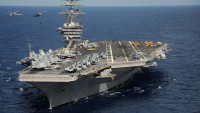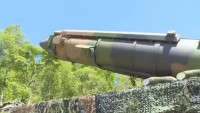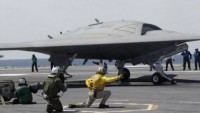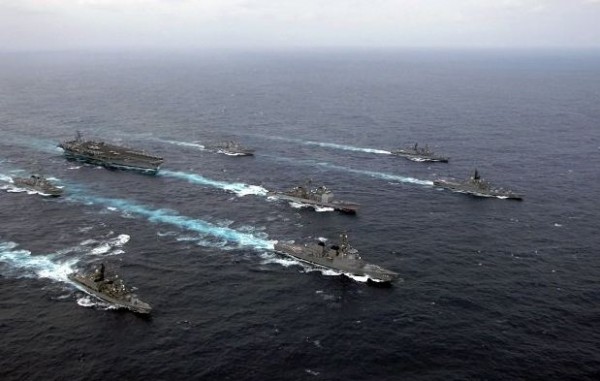China Almost Began a War against the United States in July over South China Sea
| Arthur Dominic Villasanta | | Dec 31, 2016 02:08 AM EST |
(Photo : US Navy) USS Ronald Reagan Carrier Strike Group.
Chinese state-run television has revealed China almost ignited a war against the United States in July when it aimed "dozens" of DF-21D anti-ship ballistic missiles (ASBMs) at the aircraft carrier USS Ronald Reagan (CVN-76) patrolling the South China Sea.
This startling admission was made on state-owned China Central Television (CCTV) this week. It also revealed this action that might have triggered a war with the United States occurred a few days before the Permanent Court of Arbitration in The Hague on July 12 declared illegal China's claim to own most of the South China Sea based on "historic rights."
Like Us on Facebook
CCTV said the People's Liberation Army Rocket Force (PLARF) almost launched its DF-21D ASBMs at the USS Ronald Reagan then patrolling the volatile South China Sea.
China saw the U.S. Navy's two Carrier Strike Groups in the South China Sea as an indication the U.S. was about to attack. It feared the U.S. might use its military strength to enforce the arbitration ruling.
In response to Beijing's growing paranoia, the PLARF aimed "dozens" of its DF-21Ds at the USS Ronald Reagan, which is part of the United States Seventh Fleet. Attacking the Reagan, however, would have led to massive retaliation by U.S. warships and aircraft in the South China Sea.
It might also have triggered an exchange of nuclear missiles, making World War III more than a dreadful scenario.
At this time, the Reagan was conducting joint naval drills in the South China Sea with another carrier, the USS John C. Stennis (CVN-74) from the United States Third Fleet.
The Carrier Strike Groups of the Stennis and the Reagan also consisted of two guided-missile cruisers and six guided-missile destroyers. Two nuclear attack submarines also accompanied these warships.
The two Carrier Strike Groups in these aircraft carriers consisted of 140 aircraft, including 80 F/A-18 Hornets that can either engage in air-to-air combat or attack warships of the People's Liberation Army Navy (PLAN).
This was the first two-carrier exercise in the Western Pacific in two years. The presence of the two carrier strike groups demonstrated the U.S.' unique ability to operate tandem forces in the same area at the same time and afforded a rare opportunity for joint training "in a high end scenario," said Rear Admiral John Alexander, commander of the Reagan carrier strike group.
PLARF controls China's arsenal of land-based ballistic missiles, both nuclear and conventional. It is under the direct command of the Central Military Commission headed by Chinese President Xi Jinping.
The DF-21D, which is hyped in Chinese media as a killer of U.S. aircraft carriers, is an untested, road mobile ASBM with a maximum range of 1,450 km.
The DF-21D is thought to employ maneuverable reentry vehicles (MaRVs) with a terminal guidance system.
TagsUSS Ronald Reagan, DF-21D anti-ship ballistic missile, South China Sea, China Central Television, CCTV, Permanent Court of Arbitration, People's Liberation Army Rocket Force, ASBM
©2015 Chinatopix All rights reserved. Do not reproduce without permission
 US Navy Deploys USS Carl Vinson Strike Group to Asia; Over 100 Fighter Jets Ready for War
US Navy Deploys USS Carl Vinson Strike Group to Asia; Over 100 Fighter Jets Ready for War US Navy Now Wants 355 Warships; Sends Clear Signal to China and Russia to Back-off
US Navy Now Wants 355 Warships; Sends Clear Signal to China and Russia to Back-off US Navy Reports Successful Test of Missile that can Destroy China’s DF-21D ‘Carrier Killer’
US Navy Reports Successful Test of Missile that can Destroy China’s DF-21D ‘Carrier Killer’ US Navy’s First Carrier Aerial Drone Morphs into Multi-mission Aircraft
US Navy’s First Carrier Aerial Drone Morphs into Multi-mission Aircraft
EDITOR'S PICKS
-

Did the Trump administration just announce plans for a trade war with ‘hostile’ China and Russia?
-

US Senate passes Taiwan travel bill slammed by China
-

As Yan Sihong’s family grieves, here are other Chinese students who went missing abroad. Some have never been found
-

Beijing blasts Western critics who ‘smear China’ with the term sharp power
-

China Envoy Seeks to Defuse Tensions With U.S. as a Trade War Brews
-

Singapore's Deputy PM Provides Bitcoin Vote of Confidence Amid China's Blanket Bans
-

China warns investors over risks in overseas virtual currency trading
-

Chinese government most trustworthy: survey
-

Kashima Antlers On Course For Back-To-Back Titles
MOST POPULAR
LATEST NEWS
Zhou Yongkang: China's Former Security Chief Sentenced to Life in Prison

China's former Chief of the Ministry of Public Security, Zhou Yongkang, has been given a life sentence after he was found guilty of abusing his office, bribery and deliberately ... Full Article
TRENDING STORY

China Pork Prices Expected to Stabilize As The Supplies Recover

Elephone P9000 Smartphone is now on Sale on Amazon India

There's a Big Chance Cliffhangers Won't Still Be Resolved When Grey's Anatomy Season 13 Returns

Supreme Court Ruled on Samsung vs Apple Dispute for Patent Infringement

Microsoft Surface Pro 5 Rumors and Release Date: What is the Latest?










